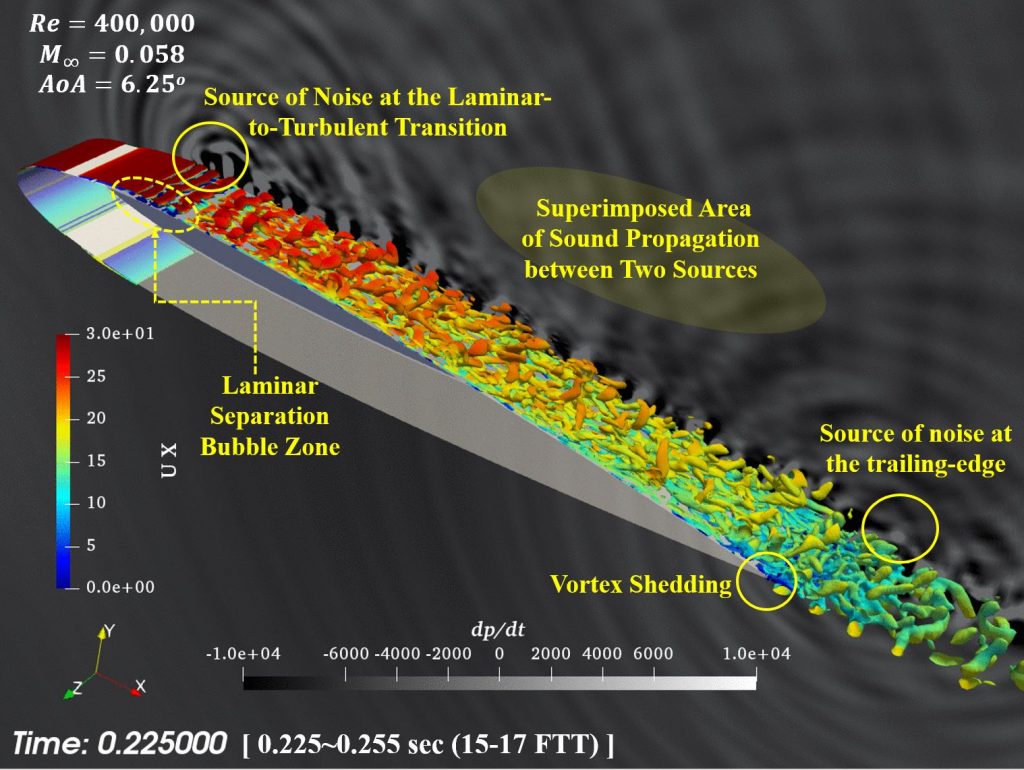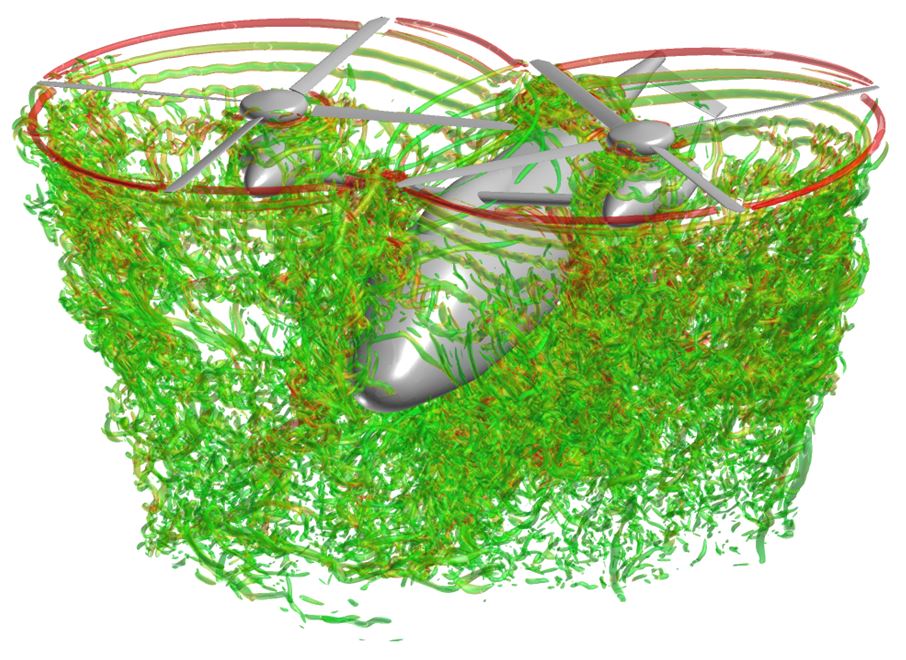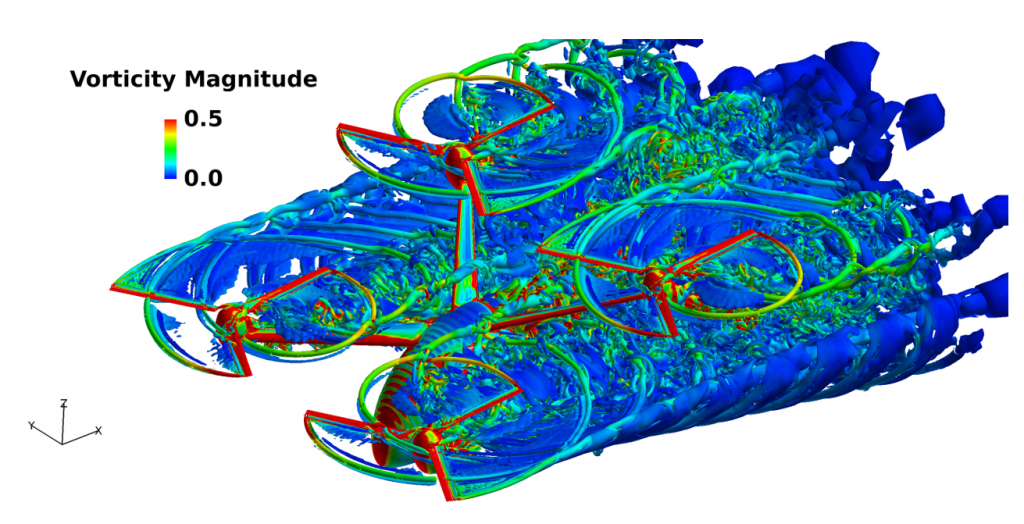Research and CFPA Lab
Current Research Funding:
- Multi-Discipline Integrated UAM Core Technology Development Center, National Research Foundation of Korea (2025-2028) (website 1, website 2)
- Proprotor and Wing Interactional Aerodynamics for Performance, Acoustics, and Vibration, US Army VLRCOE (2021-2026) (website)
- Rapid Development of Urban Air Mobility Vehicle Concepts through Full-Configuration Multidisciplinary Design, Analysis, and Optimization, NASA ULI (2021-2025) (website)
Past Research Funding:
- High-Performance, Zero-Emission, and Ultra-Quiet Aircraft Design and Operation with Over-the-Wing Distributed Propellers, UC Davis College of Engineering (2023-2024) (website)
- Multi-Particle Transport in a Complex Flow Field with Surface Impact (Dynamic Stall in Harsh Environments), Lawrence Livermore National Laboratory (2023-2024) (website)
- High-Fidelity CFD Simulations for Tonal and Broadband Noise Predictions of Urban Air Mobility Aircraft, Supernal (2021-2023)
- Broadband Noise Prediction Code Development and Optimization of Low Noise Airfoil, Hyundai (2019-2020)
- Toward Quiet Transformative Electric Vertical Aircraft, Hellman Foundation (2018)
- Loads Data Generation for Offshore Wind Turbine Rotor on Multi-Purposed Mobile Base, KIMM (Korea Institute of Machinery and Materials) (2016-2017)
- Fundamental Aeroacoustics of Coaxial Helicopter Rotors, US Army VLRCOE (2016-2020)
Research Topics:
- Turbulent Flow and Airfoil Noise
Aeroacoustics, an interdisciplinary field that combines fluid mechanics and acoustics, is dedicated to examining noise generation caused by turbulent fluid motion or aerodynamic forces interacting with surfaces. To address this challenging yet crucial issue, we are delving into the complex, unsteady fluid dynamics and turbulent flows, while also formulating new theories and computational algorithms to forecast the inception and transmission of aerodynamically induced noise. One notable example in this domain is the turbulent boundary layer trailing-edge noise of airfoils. We are in the process of devising efficient and precise numerical methods to predict trailing edge noise. Additionally, we employ Large Eddy Simulations (LES) to scrutinize the intricate flow physics related to noise generation and propagation. Our research endeavors contribute significantly to the advancement of aerospace engineering and science, as well as the fundamental knowledge and comprehension of unsteady flows, turbulence, and aeroacoustics.


(Image credit: Donghun Kang (PhD student) – LES for airfoil noise)
- Rotorcraft Aerodynamics and Aeroacoustics
Rotorcraft possess the unique ability to hover and perform vertical take-offs and landings. However, noise generated by rotorcraft poses challenges in terms of public acceptance in urban environments and detection in military operations. To address these issues, we utilize high-fidelity computational fluid dynamics (CFD) and computational structural dynamics (CSD) coupling simulations to calculate aerodynamic forces, wake flows, and elastic blade motions. Based on these flow fields and trim solutions, we predict the tonal and broadband noise produced by rotating blades. A recent application of our research focuses on transformative electric vertical take-off and landing (eVTOL) aircraft, also known as urban air mobility or air taxis. Additionally, we have developed a novel rotor broadband noise software called UCD-QuietFly, which has gained widespread adoption in both academia and industry. By exploring innovative ideas to reduce rotorcraft noise, we aim to improve public acceptance of rotorcraft in urban settings and minimize the detection of rotorcraft during military operations.

(Image credit: Henry Jia (PhD student) – Lift-offset coaxial rotor CFD simulations)

(Image credit: Jared Sagaga (PhD student) – Side-by-side rotor CFD simulations)
- Propeller Aerodynamics and Aeroacoustics & Aircraft Engine Noise
With the advent of electric aircraft, propeller noise has garnered renewed interest. This renewed focus is crucial for addressing the unique challenges and demands of electric propulsion systems, ensuring their integration into the aviation industry while minimizing the impact on the environment and communities. We are working on predicting propeller tonal and broadband noise by utilizing low-, medium-, and high-fidelity computational models. Additionally, we explore innovative concepts to mitigate propeller noise. Our efforts extend to the application of the propeller and wing interaction and its impact on aircraft performance, aerodynamics, and acoustics. Furthermore, we investigate the interaction of aircraft engine noise with the fuselage, which is considered an acoustic scattering problem or propulsion airframe integration. (Image credit: Henry Jia (PhD student) – Quadrotor full vehicle CFD)
(Image credit: Henry Jia (PhD student) – Quadrotor full vehicle CFD) - Wind Energy Aerodynamics and Aeroacoustics
Wind energy is experiencing exponential growth worldwide and has recently emerged as a mainstream source of power. To further reduce the cost of wind energy and expedite wind turbine installations, it is crucial to enhance aerodynamic efficiency and optimize wind energy capture. Moreover, wind turbine noise has become a concern for obtaining building permits in residential areas. Our lab focuses on wind turbine aerodynamics and aeroacoustic research. One specific area of interest is unsteady aerodynamics and dynamic stall prediction and mitigation. We employ computational fluid dynamics (CFD) to advance technology and knowledge in wind energy. Our research contributes to the development of next-generation environmentally friendly renewable energy sources.
 (Image credit: Jagdeep Batther (MS student) – Dynamic stall prediction using DDES)
(Image credit: Jagdeep Batther (MS student) – Dynamic stall prediction using DDES)
